
Bluetooth Technology Update for Audiologists
Brian Taylor, Au.D.
Wireless technology, from telecoils to FM systems has been a part of hearing aid dispensing practices for generations. About 20 years ago, with much fanfare, Bluetooth® technology was introduced into hearing aids. Cumbersome and clumsy, the original Bluetooth® wireless streaming system in hearing aids required the use of a separate transmitter worn around the patient’s neck.
Starting around 2014, wireless technology in hearing aids changed with the advent of direct Bluetooth® streaming. Today, ten years later, most prescription hearing aids and even a handful of over-the-counter hearing aids, come standard with some type of wireless Bluetooth® streaming capability built directly into them. The purpose of this brief infographic is to highlight the recent Bluetooth® advances around LE Audio and Auracast and what they mean for clinicians.
Let’s start with the basics. Bluetooth® is the name of the standardization that covers a wide range of different use types of wireless transmission. Bluetooth® relies on short-range radio frequency, and any device that incorporates the technology can communicate with other Bluetooth-enabled devices as long as they are within the required distance of each other, which is about 30 feet.
 It is also important to know that Bluetooth technology is governed by a special interest group called Bluetooth® Special Interest Group (SIG). The Bluetooth® SIG has been working closely with hearing aid manufacturers for more than a decade to bring a universal, wireless hearing aid standard to market. Before we discuss these new standards, let’s next examine, more broadly, how Bluetooth® technology works with hearing aids.
It is also important to know that Bluetooth technology is governed by a special interest group called Bluetooth® Special Interest Group (SIG). The Bluetooth® SIG has been working closely with hearing aid manufacturers for more than a decade to bring a universal, wireless hearing aid standard to market. Before we discuss these new standards, let’s next examine, more broadly, how Bluetooth® technology works with hearing aids.
Currently the hearing industry has implemented four wireless protocols, all of which are used for both data & audio transmission. An example of data transmission between hearing aids is when one device, say in the left hearing aid, has its digital noise reduction activated which, in turn, automatically activates digital noise reduction in the right hearing aid. In contrast, audio transmission occurs when the amplified sound in one hearing aid is transmitted or shared with the other hearing aid. The prime example of audio transmission is bilateral beamforming in which the two microphones in each hearing aid share or exchange information with each other.
The four wireless protocols are Bluetooth Classic, Apple’s Made for iPhone (MFi), Google’s Audio Streaming for Hearing Aids (ASHA), and the new Bluetooth Low Energy Audio. Hearing aids and other Bluetooth enabled devices often utilize more than one of these protocols to maximize the advantages while minimizing any disadvantages. Table 1 below shows the various advantages & disadvantages of each wireless protocol.
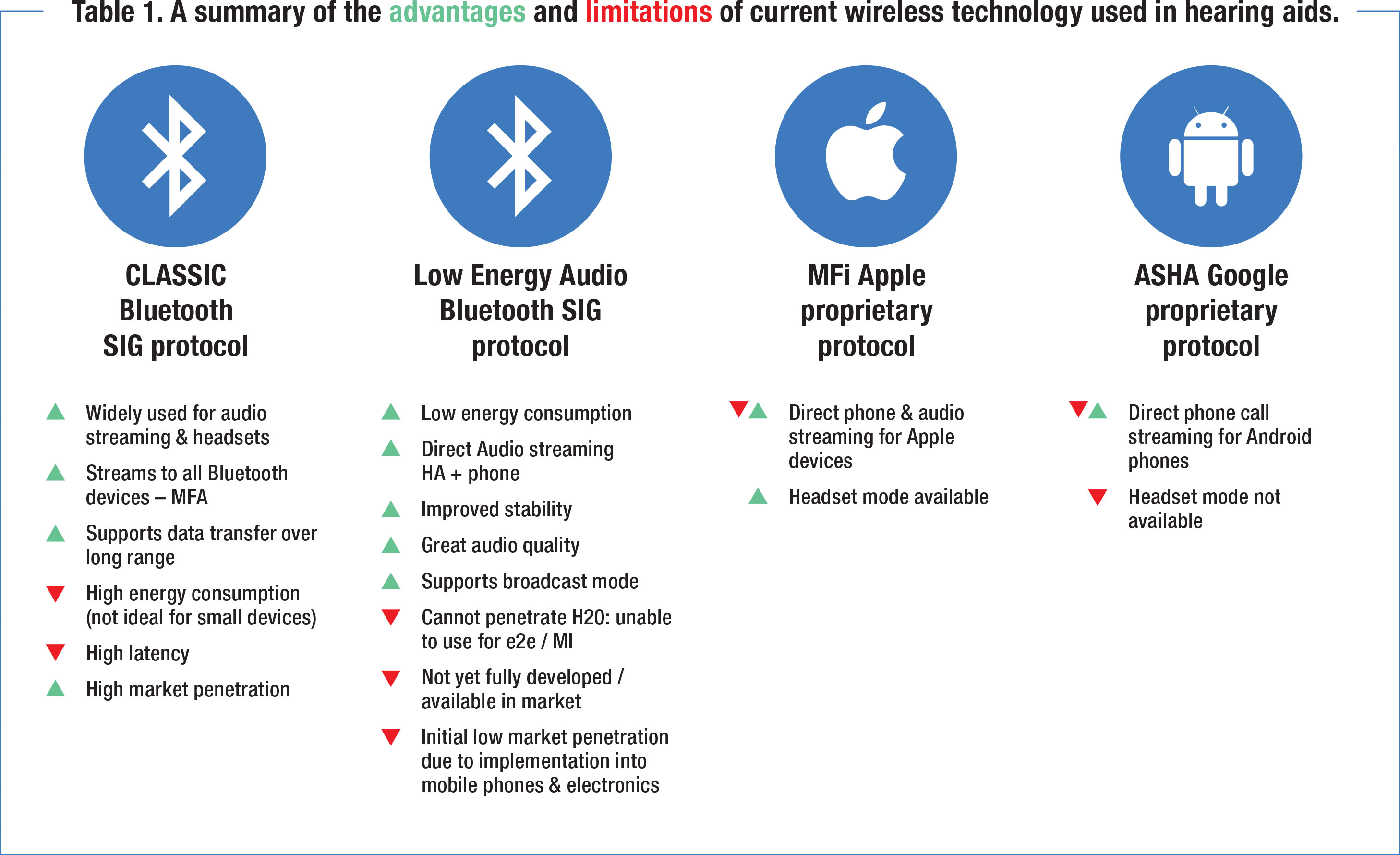
In 2023, after more than 10 years of collaborative efforts, hearing aid manufacturers and the Bluetooth® SIG unveiled a new generation of Bluetooth®, one that will eventually benefit the lives of millions of hearing aid wearers and their communication partners. Audiologists and persons with hearing loss can look forward to two major breakthroughs in this new generation of Bluetooth wireless transmission: Auracast and LE Audio. Next, we examine the key differences between these two wireless Bluetooth technologies.
LE Audio
Bluetooth® Low Energy (LE) Audio streams audio signals directly between smartphones and hearing aids with excellent stability, audio quality, and low energy consumption. Starting in 2024, when a person acquires an updated smartphone, there is a good chance it will have LE Audio built in. This means hearing aids with LE Audio capability will make direct Bluetooth® streaming simpler, and with improved sound quality, than it is today. Experts believe it will take about five years to see a significant uptake in smartphones that come standard with LE Audio, but that transfer is taking place today, albeit slowly.
Auracast™
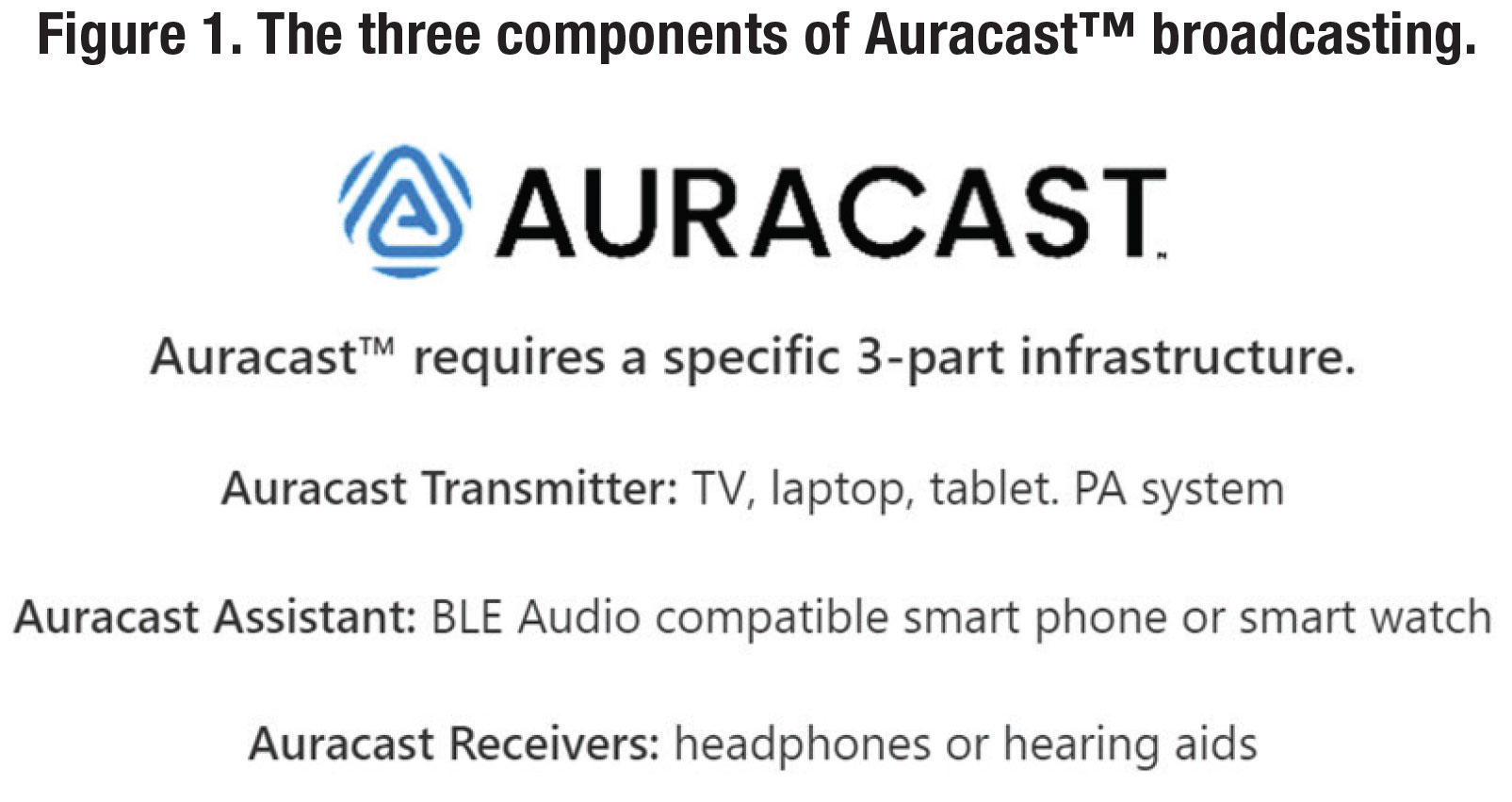 An added bonus is that the Bluetooth® LE Audio protocol can support a broadcast mode, which is called Auracast™. Although Bluetooth® LE Audio and Auracast™ protocols are linked together, the technical hardware requirements are not the same. You can have a device that has Bluetooth® LE Audio but does not have Auracast™ capabilities. Figure 1 is a summary of the various components of Auracast.™
An added bonus is that the Bluetooth® LE Audio protocol can support a broadcast mode, which is called Auracast™. Although Bluetooth® LE Audio and Auracast™ protocols are linked together, the technical hardware requirements are not the same. You can have a device that has Bluetooth® LE Audio but does not have Auracast™ capabilities. Figure 1 is a summary of the various components of Auracast.™
Auracast™ is capable of broadcasting streaming audio from one device (TV/laptop) to multiple devices (earbuds + hearing aids) enabling the audio signal to be broadcasted to many users simultaneously. The way Auracast™ works is akin to how public Wi-Fi connects with your smartphone today. When you walk into, say, an airport or restaurant, your smartphone is prompted to open the Wi-Fi on your smartphone. Once you see the prompt for the local Wi-Fi, you usually next enter a password and begin using the internet connection. Essentially, the same sequence of events occurs with Auracast™ broadcasting. If your smartphone is Auracast™-enabled LE Audio, with a password, you will have the ability to wirelessly connect to any Auracast™ transmitter.
The primary use case for Auracast™ is predicted to be for spaces where public address (PA) systems and hearing loops systems currently exist. Additional use cases of Auracast™ are anticipated to be silent TVs as seen in airports, restaurants, and other public spaces where multiple end users can stream the audio from that television to their own personal devices as well as one-to-one assistive listening at public service counters or reception desks. The latter use case is an example of “shared audio” in which one person can share the audio from their laptop or smartphone with another person’s earbuds or hearing aids.
How Auracast™ Broadcast Audio Works
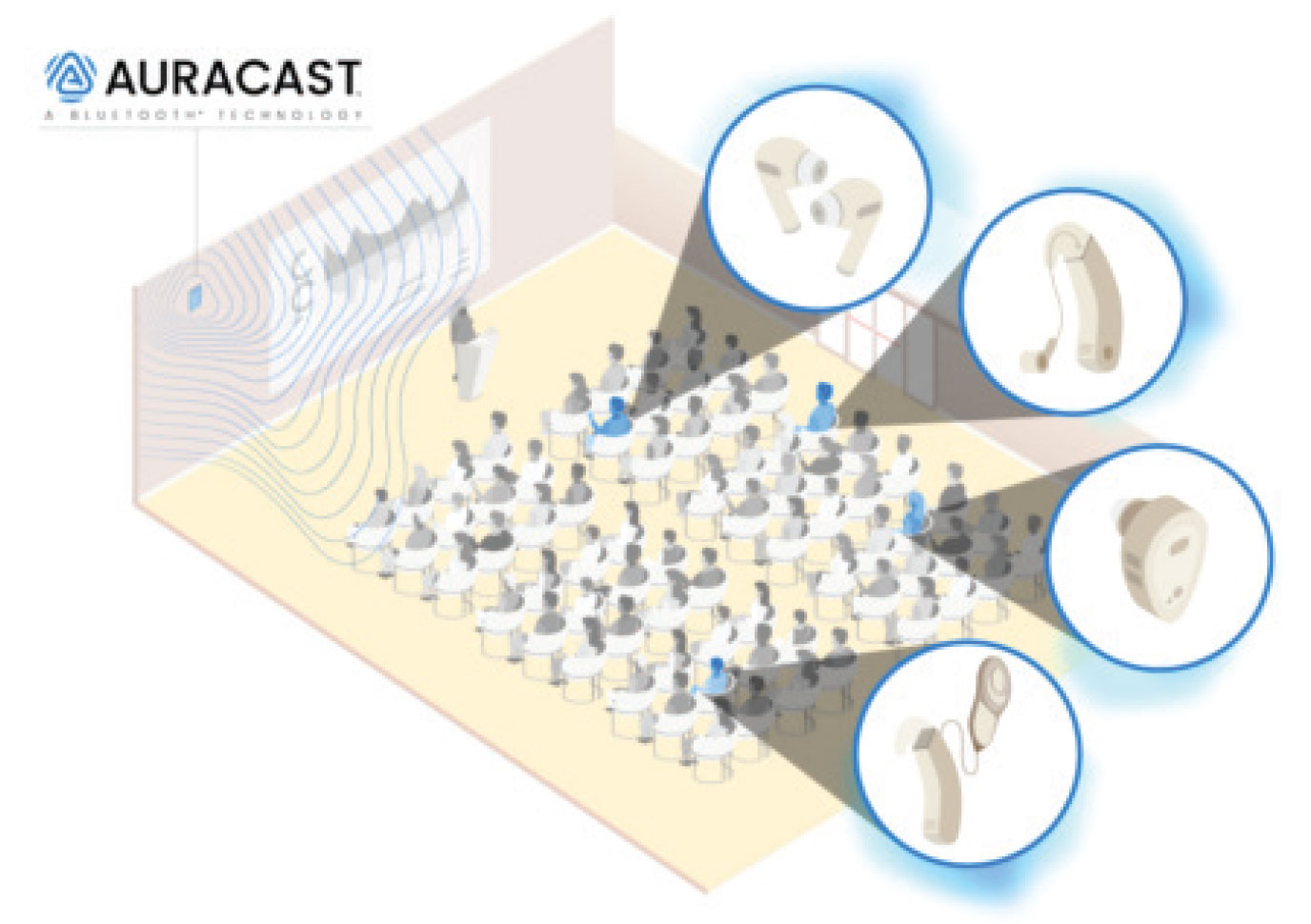 With Auracast™ broadcast audio, an unlimited number of in-range Auracast™ receivers will be able to join an Auracast ™ broadcast from a nearby Auracast™ transmitter.
With Auracast™ broadcast audio, an unlimited number of in-range Auracast™ receivers will be able to join an Auracast ™ broadcast from a nearby Auracast™ transmitter.
Connecting to an Auracast™ broadcast audio stream is not the same as a standard pairing between two Bluetooth® devices. With an Auracast™ broadcast audio stream, a transmitter advertises the availability and information details of the stream. Any Auracast™ receiver or assistant can listen for that broadcast and join based on the user’s request. At the heart of a broadcast, the transmitter does not know what types or how many devices are listening to the Auracast™ broadcast audio stream. This allows for one transmitter to broadcast to an unlimited number of receivers within range. Some broadcasts may be encrypted and require additional input by the user, depending on the implementation.
A smartphone is not required to listen to an Auracast™ broadcast audio stream. This of course is one of the significant benefits of Auracast™ for hearing aid wearers. Once joined, the receiver listens to a direct audio stream from the transmitter. The smartphone is not involved in the listening process. That said, there are two common methods for finding and joining an Auracast™ broadcast audio stream – with and without an assistant (e.g., smartphone or smartwatch).
Joining With an Assistant
In either instance, it starts with a transmitter advertising the availability of an Auracast™ broadcast audio stream. With an assistant, such as a smartphone, the assistant scans for available broadcasts, providing an interface for the user to choose which broadcast to join. Once the broadcast is selected by the user, the assistant directs the receiver to join that broadcast directly. The assistant (smartphone) is then no longer involved in the listening transaction. This method is similar to the method used for discovering a Wi-Fi access point and will likely be the most common method for used to find and join broadcast streams in public spaces. Figure 2 below is a schematic showing how joining with an assistant works.
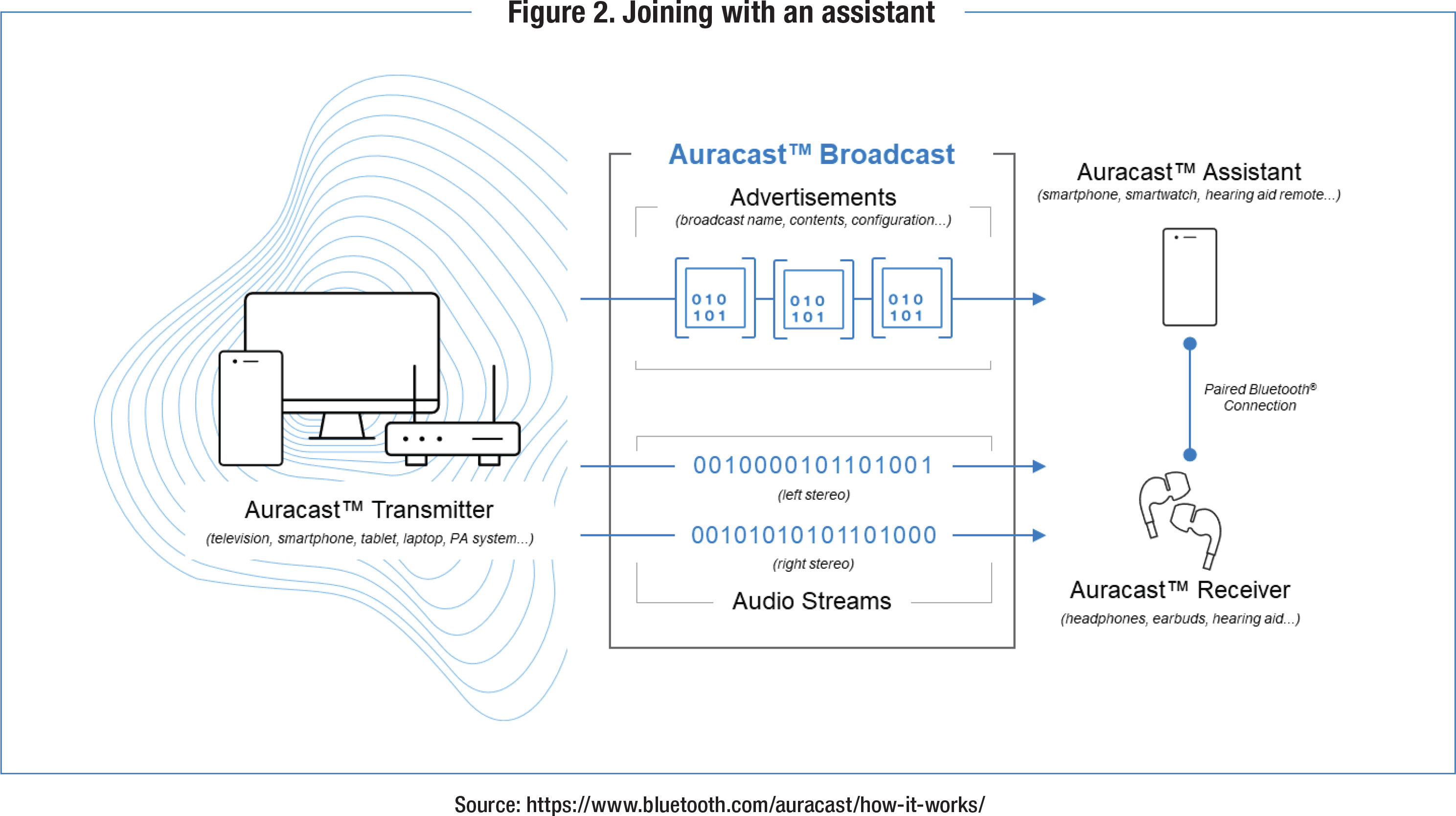
Joining Without an Assistant
Without an assistant, the process for finding and joining a broadcast stream is similar. The difference is the receiver, which is built into the hearing aids, scans for an available broadcast and provides the mechanism on the device (button, switch, etc.) to join the broadcast stream. This method, shown in Figure 4, may not be ideal for devices that are size or resource constrained or when multiple streams are available.
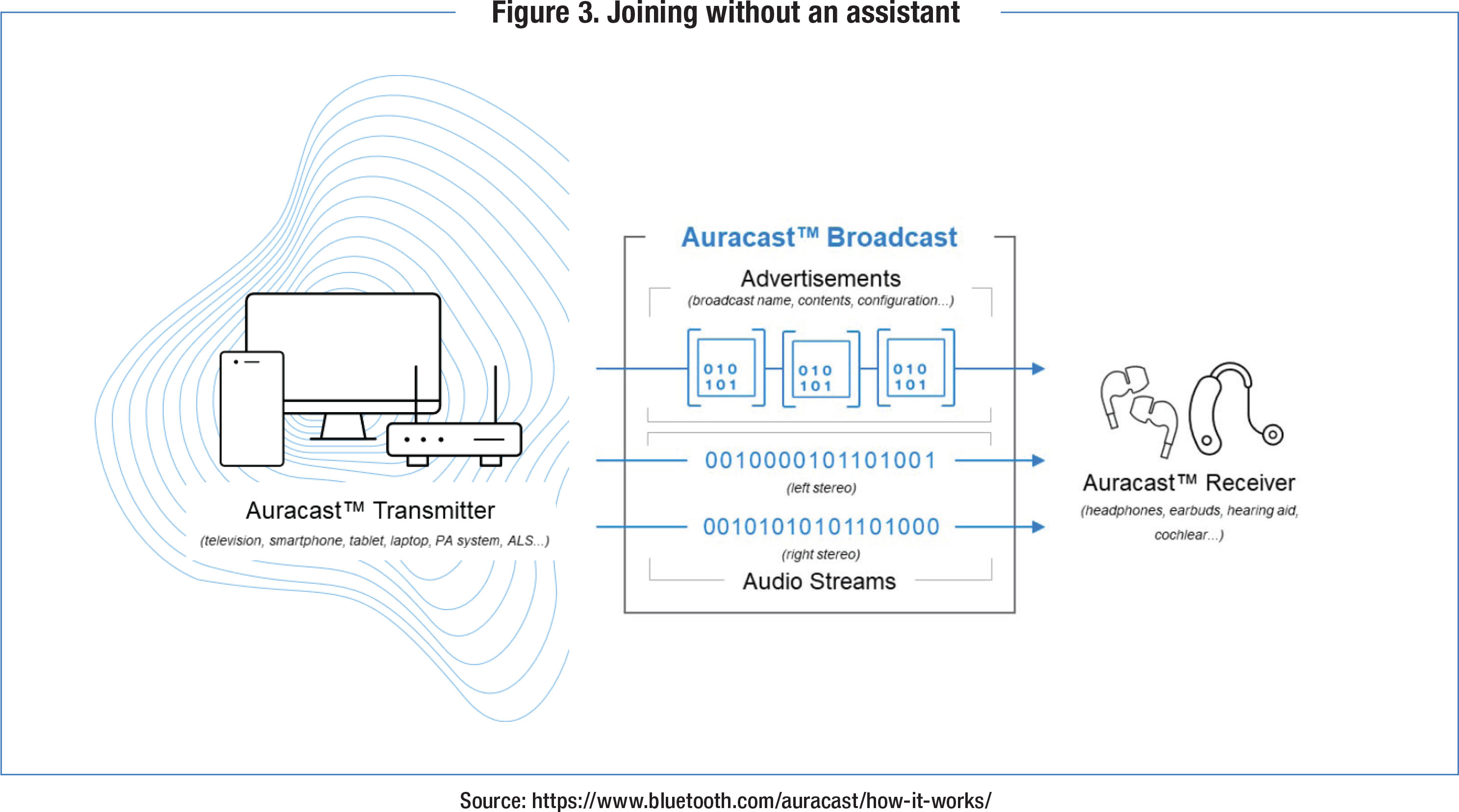
Deployment of Auracast™ has just begun and is still in its infancy, with ongoing discussions in the standardization group about the user interface and optimal setup. Auracast™ needs time to penetrate the market due to the required 3-part infrastructure of a transmitter (TV/laptop), BLE Audio compatible smartphone, and BLE Audio receivers (hearing aids/headphones), as outlined in Figure 1.
Experts believe Auracast™ availability will grow slowly through 2024 and 2025, and then spread to more general use around 2030. In public places, this use case is largely covered by induction loop systems today. Further, experts think the current assistive listening systems such as loops systems will remain in use until at least 2030, while new installations of group assistive listening systems through 2030 and beyond are likely to be Auracast™ installations.
It will take time for Bluetooth LE Audio to be fully integrated into the market. Consumer electronics (e.g., earbuds) and hearing aid manufacturers will continue to use dual-mode Bluetooth protocols to ensure end users can use existing infrastructure while the new Bluetooth LE Audio protocol is adopted.
Auracast™ needs time to mature into a stable, reliable, and user-friendly technology that can be easily adopted by end-users including hearing aid wearers. Currently all major hearing aid manufacturers continue to support both Made for iPhone and ASHA protocols to enable data and audio streaming between hearing aids and smartphones.
Auracast™ is in its infancy, thus clinicians should not anticipate broad general use of Auracast™ especially in public spaces until at least 2030. As hearing aid manufacturers get closer to releasing Auracast™ enabled devices, clinicians should inquire about any updates with their industry partners. As of January 2024, Resound is the only manufacturer with LE Audio capability, but others anticipate its launch within the next year or two. For additional information, go to Bluetooth.com.
LE Audio Frequently Asked Questions
Given that LE Audio and Auracast™ are new technologies, many audiologists are likely to have questions on its implementation and use. For that reason, here are some commonly frequently asked questions.
- How should audiologists talk about LE Audio and Auracast™ with hearing aid wearers in 2024?
Individuals who purchase hearing aids in 2024 should be advised that LE Audio wireless streaming in on the way, but that in order to use it, you’ll need other new consumer electronic devices that have the Auracast transmitter and assistant built in. For example, you could purchase hearing aids today with LE Audio capability, but without at least the transmitter, the LE Audio feature on the hearing aid cannot be activated. - Should audiologists actively promote that many hearing aids purchased in 2024 already have LE Audio or will have firmware upgrades enabling use of LE Audio and Auracast™?
Like the response to the first question, hearing aid purchasers in 2024 should know that LE Audio is available. However, since the transmitters and assistants are just beginning to roll out, other types of wireless streaming that have been around several years (see Table 1) should, at least for the next several months, remain the priority for most wearers. In some cases, hearing aid wearers who happen to be early adaptors of new consumer electronic devices might appreciate that some devices right now have LE Audio in them. This gives them a leg up on incorporating Auracast™ into their daily lives. - What should audiologists anticipate from hearing aid manufacturers in 2024 as LE Audio begins to roll out?
It’s a safe bet that all manufacturers of prescription hearing aids have LE Audio capability in their product launch pipeline for 2024 or 2025. As of January 2024, GN is the only manufacturer that has LE Audio capability built into its latest model. Others are planning to add it in 2024 with a simple firmware update on some existing models. It is best to communicate directly with your manufacturing partner because launch plans can change quickly. - Once Auracast™ and LE Audio gain traction, how much will audiologists be called upon to help or counsel patients on how to successfully use it?
Over the next few years, as these technologies grow in popularity, it is a sure bet that audiologists will be called upon to troubleshoot and counsel hearing aid wearers on its use. Unlike current forms of wireless transmission, LE Audio does tend to be simpler to use, but given the demographics of hearing aid wearers, audiologist will always be called upon to provide hands-on assistance with any type of new wireless system.
Now is a good time to get familiar with the basics of LE Audio. You can do this by going to www.bluetooth.com/ auracast. At this link you will get feature/benefit overviews and links to other resources. Additionally, if you have an audiology assistant or technician in your practice, encourage that person to be the “local expert” on LE Audio.
Finally, now is a great time to start screening the digital literacy of all prospective hearing aid wearers. The 2-question version of the Mobile Device Proficiency Questionnaire is a validated approach to assessing the individual’s proficiency at handling a smartphone, which is a cornerstone of LE Audio use. Here are the two questions and the possible answers to each question.
- “How would you rate your skill level with a smartphone?”
- Never used one
- Never used one
- Never used one
- “How confident are you using a smartphone?”
- Not confident at all
- I usually need help
- It depends on the task
- I am confident in my ability to use a smartphone
If the prospective hearing aid wearer answers that they are competent and confident (bottom response to each question), that is a strong indication the individual can readily use LE Audio without assistance. Any other response to either question suggests the wearer will need some extra instruction or should perhaps avoid technologies that require the use of a smartphone. ■
The author would like to thank Chuck Sabin of the Bluetooth SIG for his valuable insights as well as granting permission to use the infographics.
Brian Taylor is the editor of Audiology Practices and can be reached at
